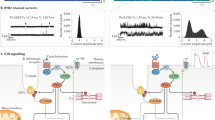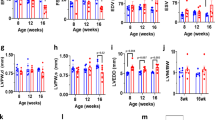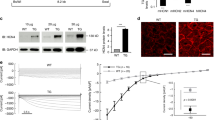Abstract
In an attempt to compensate for compromised hemodynamics in heart failure, neurohumoral mechanisms are activated that trigger fundamental changes in gene expression and in protein processing, trafficking and post-translational regulation, resulting in myocyte hypertrophy. Unfortunately, over time these changes become maladaptive, predisposing to myocyte loss, chamber dilatation, interstitial hyperplasia and intercellular uncoupling. Intrinsic and peripheral responses to mechanical dysfunction alter the expression and function of key ion channels and calcium-handling proteins, thereby remodeling the cellular action potential and the intracellular calcium transient. This electrophysiological remodeling renders the heart more vulnerable to ventricular arrhythmias that underlie sudden cardiac death. In this Review, we consider key ventricular ionic changes that are associated with heart failure, with the intention of identifying molecular targets for antiarrhythmic therapy.
Key Points
-
Ion channel dysfunction is a hallmark of heart failure, underlying much of the electrical remodeling that occurs at the cellular level in the failing heart and predisposing individuals to ventricular arrhythmias
-
Alterations in sodium, potassium and calcium channels and transporters result in overall prolongation of the cellular action potential, an increase in the spatiotemporal gradients of repolarization, a slowing of conduction velocity, an enhanced propensity for arrhythmic triggers and conduction block—all of which combine to form a hostile environment ripe for the generation of malignant arrhythmias
-
Abnormalities in intracellular calcium cycling form an important mechanistic link between electrical and contractile dysfunction
-
Elucidation of arrhythmia mechanisms at the basic ionic level will help improve traditional pharmacological therapies and facilitate the design of novel approaches, including cell-transfer and gene-transfer strategies designed to target ion channels and transporters
This is a preview of subscription content, access via your institution
Access options
Subscribe to this journal
Receive 12 print issues and online access
$209.00 per year
only $17.42 per issue
Buy this article
- Purchase on Springer Link
- Instant access to full article PDF
Prices may be subject to local taxes which are calculated during checkout


Similar content being viewed by others
References
Schocken DD et al. (1992) Prevalence and mortality rate of congestive heart failure in the United States. J Am Coll Cardiol 20: 301–306
Tomaselli GF et al. (1994) Sudden cardiac death in heart failure: the role of abnormal repolarization. Circulation 90: 2534–2539
Estes NAM 3rd et al. (2003) Use of antiarrhythmics and implantable cardioverter-defibrillators in congestive heart failure. Am J Cardiol 91 (Suppl 1): S45–S52
Echt DS et al. (1991) Mortality and morbidity in patients receiving encainide, flecainide, or placebo: the Cardiac Arrhythmia Suppression Trial. N Engl J Med 324: 781–788
Schram G et al. (2002) Differential distribution of cardiac ion channel expression as a basis for regional specialization in electrical function. Circ Res 90: 939–950
Akar FG and Rosenbaum DS (2003) Transmural electrophysiological heterogeneities underlying arrhythmogenesis in heart failure. Circ Res 93: 638–645
Berger RD et al. (1997) Beat-to-beat QT interval variability: novel evidence for repolarization lability in ischemic and nonischemic dilated cardiomyopathy. Circulation 96: 1557–1565
Nattel S et al. (2005) Mechanisms of atrial remodeling and clinical relevance. Curr Opin Cardiol 20: 21–25
Nattel S and Li D (2000) Ionic remodeling in the heart: pathophysiological significance and new therapeutic opportunities for atrial fibrillation. Circ Res 87: 440–447
Tomaselli GF and Marban E (1999) Electrophysiological remodeling in hypertrophy and heart failure. Circ Res 42: 270–283
Akar FG et al. (2004) Mechanisms underlying conduction slowing and arrhythmogenesis in nonischemic dilated cardiomyopathy. Circ Res 95: 717–725
Pajouh M et al. (2005) IKs blockade reduces dispersion of repolarization in heart failure. Heart Rhythm 2: 731–738
Greenstein JL et al. (2000) Role of the calcium-independent transient outward current I(to1) in shaping action potential morphology and duration. Circ Res 87: 1026–1033
Carmeliet E (1993) K+ channels and control of ventricular repolarization in the heart. Fundam Clin Pharmacol 7: 19–28
Rozanski GJ et al. (1998) Altered K+ current of ventricular myocytes in rats with chronic myocardial infarction. Am J Physiol 274: H259–H265
Kaab S et al. (1998) Molecular basis of transient outward potassium current downregulation in human heart failure: a decrease in Kv4.3 mRNA correlates with a reduction in current density. Circulation 98: 1383–1393
Guo W et al. (1999) Molecular basis of transient outward K+ current diversity in mouse ventricular myocytes. J Physiol 521: 587–599
Akar FG et al. (2004) Phenotypic differences in transient outward K+ current of human and canine ventricular myocytes: insights into molecular composition of ventricular Ito. Am J Physiol Heart Circ Physiol 286: H602–H609
Akar FG et al. (2005) Molecular mechanisms underlying potassium current down-regulation in heart failure. Am J Physiol Heart Circ Physiol 288: H2887–H2896
Lebeche D et al. (2004) In vivo cardiac gene transfer of Kv4.3 abrogates the hypertrophic response in rats after aortic stenosis. Circulation 110: 3435–3443
Pourrier M et al. (2003) Properties, expression and potential roles of cardiac K+ channel accessory subunits: MinK, MiRPs, KChIP, and KChAP. J Membr Biol 194: 141–152
Jerng HH et al. (2004) Molecular physiology and modulation of somatodendritic A-type potassium channels. Mol Cell Neurosci 27: 343–369
An WF et al. (2000) Modulation of A-type potassium channels by a family of calcium sensors. Nature 403: 553–556
Rosati B et al. (2001) Regulation of KChIP2 potassium channel beta subunit gene expression underlies the gradient of transient outward current in canine and human ventricle. J Physiol 533: 119–125
McCrossan ZA and Abbott GW (2004) The MinK-related peptides. Neuropharmacology 47: 787–821
Wang Z et al. (1998) Differential distribution of inward rectifier potassium channel transcripts in human atrium versus ventricle. Circulation 98: 2422–2428
Nuss HB et al. (1999) Cellular basis of ventricular arrhythmias and abnormal automaticity in heart failure. Am J Physiol 277: H80–H91
Miake J et al. (2002) Biological pacemaker created by gene transfer. Nature 419: 132–133
Warren M et al. (2003) Blockade of the inward rectifying potassium current terminates ventricular fibrillation in the guinea pig heart. J Cardiovasc Electrophysiol 14: 621–631
Noujaim SF et al. (2007) Up-regulation of the inward rectifier K+ current (I K1) in the mouse heart accelerates and stabilizes rotors. J Physiol 578: 315–326
Nattel S (2000) Acquired delayed rectifier channelopathies: how heart disease and antiarrhythmic drugs mimic potentially-lethal congenital cardiac disorders. Cardiovasc Res 48: 188–190
Li GR et al. (2002) Transmural action potential and ionic current remodeling in ventricles of failing canine hearts. Am J Physiol Heart Circ Physiol 283: H1031–H1041
Tsuji Y et al. (2006) Potassium channel subunit remodeling in rabbits exposed to long-term bradycardia or tachycardia: discrete arrhythmogenic consequences related to differential delayed-rectifier changes. Circulation 113: 345–355
Han W et al. (2001) Ionic remodeling of cardiac Purkinje cells by congestive heart failure. Circulation 104: 2095–2100
Akar FG et al. (2002) Unique topographical distribution of M cells underlies reentrant mechanism of torsade de pointes in the long-QT syndrome. Circulation 105: 1247–1253
Choy A-M et al. (1996) Regional expression of HERG and KvLQT1 in heart failure. Circulation 94: 164
Ehrlich JR et al. (2004) KvLQT1 modulates the distribution and biophysical properties of HERG: a novel α-subunit interaction between delayed rectifier currents. J Biol Chem 279: 1233–1241
Nuss HB et al. (1999) Overexpression of a human potassium channel suppresses cardiac hyperexcitability in rabbit ventricular myocytes. J Clin Invest 103: 889–896
Mazhari R et al. (2002) Ectopic expression of KCNE3 accelerates cardiac repolarization and abbreviates the QT interval. J Clin Invest 109: 1083–1090
Kimura S et al. (1991) Differences in the effect of metabolic inhibition on action potentials and calcium currents in endocardial and epicardial cells. Circulation 84: 768–777
O'Rourke B (2000) Myocardial K(ATP) channels in preconditioning. Circ Res 87: 845–855
Akar FG et al. (2005) The mitochondrial origin of postischemic arrhythmias. J Clin Invest 115: 3527–3535
Aon MA et al. (2006) Mitochondrial criticality: a new concept at the turning point of life or death. Biochim Biophys Acta 1762: 232–240
Baruscotti M and Difrancesco D (2004) Pacemaker channels. Ann NY Acad Sci 1015: 111–121
Cerbai E et al. (1997) Characterization of the hyperpolarization-activated current, I(f), in ventricular myocytes from human failing heart. Circulation 95: 568–571
Hoppe UC et al. (1998) Hyperpolarization-activated inward current in ventricular myocytes from normal and failing human hearts. Circulation 97: 55–65
Cerbai E et al. (1996) Occurrence and properties of the hyperpolarization-activated current If in ventricular myocytes from normotensive and hypertensive rats during aging. Circulation 94: 1674–1681
Ludwig A et al. (1998) A family of hyperpolarization-activated mammalian cation channels. Nature 393: 587–591
Santoro B et al. (1998) Identification of a gene encoding a hyperpolarization-activated pacemaker channel of brain. Cell 93: 717–729
Zicha S et al. (2005) Sinus node dysfunction and hyperpolarization-activated (HCN) channel subunit remodeling in a canine heart failure model. Cardiovasc Res 66: 472–481
Tse HF et al. (2006) Bioartificial sinus node constructed via in vivo gene transfer of an engineered pacemaker HCN channel reduces the dependence on electronic pacemaker in a sick-sinus syndrome model. Circulation 114: 1000–1011
Mulder P and Thuillez C (2006) Heart rate slowing for myocardial dysfunction/heart failure. Adv Cardiol 43: 97–105
Brooksby P et al. (1993) The electrophysiological characteristics of hypertrophied ventricular myocytes from the spontaneously hypertensive rat. J Hypertens 11: 611–622
Cerbai E et al. (1994) Ionic basis of action potential prolongation of hypertrophied cardiac myocytes isolated from hypertensive rats of different ages. Cardiovasc Res 28: 1180–1187
Richard S et al. (1998) Ca2+ currents in compensated hypertrophy and heart failure. Cardiovasc Res 37: 300–311
Hill JA (2003) Electrical remodeling in cardiac hypertrophy. Trends Cardiovasc Med 13: 316–322
Ouadid H et al. (1995) Calcium currents in diseased human cardiac cells. J Cardiovasc Pharmacol 25: 282–291
Ryder KO et al. (1993) Membrane current changes in left ventricular myocytes isolated from guinea pigs after abdominal aortic coarctation. Cardiovasc Res 27: 1278–1287
Schroder F et al. (1998) Increased availability and open probability of single L-type calcium channels from failing compared with nonfailing human ventricle. Circulation 98: 969–976
Sipido KR et al. (1998) A critical role for L-type Ca2+ current in the regulation of Ca2+ release from the sarcoplasmic reticulum in human ventricular myocytes from dilated cardiomyopathy. Ann NY Acad Sci 853: 353–356
Cingolani E et al. (2007) Gene therapy to inhibit the calcium channel β subunit: physiological consequences and pathophysiological effects in models of cardiac hypertrophy. Circ Res 101: 166–175
Samie FH et al. (2000) A mechanism of transition from ventricular fibrillation to tachycardia: effect of calcium channel blockade on the dynamics of rotating waves. Circ Res 86: 684–691
Catterall WA (2000) Structure and regulation of voltage-gated Ca2+ channels. Annu Rev Cell Dev Biol 16: 521–555
Clozel JP et al. (1999) Voltage-gated T-type Ca2+ channels and heart failure. Proc Assoc Am Physicians 111: 429–437
Nuss HB and Houser SR (1993) T-type Ca2+ current is expressed in hypertrophied adult feline left ventricular myocytes. Circ Res 73: 777–782
Wang HS and Cohen IS (2003) Calcium channel heterogeneity in canine left ventricular myocytes. J Physiol 547: 825–833
Winslow RL et al. (1999) Mechanisms of altered excitation-contraction coupling in canine tachycardia-induced heart failure, II: model studies. Circ Res 84: 571–586
O'Rourke B et al. (1999) Mechanisms of altered excitation-contraction coupling in canine tachycardia-induced heart failure, I: experimental studies. Circ Res 84: 562–570
Levine BA et al. (1999) Sites on the cytoplasmic region of phospholamban involved in interaction with the calcium-activated ATPase of the sarcoplasmic reticulum. Eur J Biochem 264: 905–913
McKenna E et al. (1996) Dissociation of phospholamban regulation of cardiac sarcoplasmic reticulum Ca2+ATPase by quercetin. J Biol Chem 271: 24517–24525
Ohizumi Y et al. (1996) Stimulation of sarcoplasmic reticulum Ca(2+)-ATPase by gingerol analogues. Biol Pharm Bull 19: 1377–1379
del Monte F et al. (2001) Overwhelming evidence of the beneficial effects of SERCA gene transfer in heart failure. Circ Res 88: E66–E67
Sakata S et al. (2007) Targeted gene transfer increases contractility and decreases oxygen cost of contractility in normal rat hearts. Am J Physiol Heart Circ Physiol 292: H2356–H2363
Sakata S et al. (2007) Restoration of mechanical and energetic function in failing aortic-banded rat hearts by gene transfer of calcium cycling proteins. J Mol Cell Cardiol 42: 852–861
Hasenfuss G et al. (1997) Calcium handling proteins in the failing human heart. Basic Res Cardiol 92 (Suppl 1): S87–S93
del Monte F et al. (2002) Targeting phospholamban by gene transfer in human heart failure. Circulation 105: 904–907
Janczewski AM et al. (2004) Phospholamban gene ablation improves calcium transients but not cardiac function in a heart failure model. Cardiovasc Res 62: 468–480
Bers DM et al. (2002) Upregulated Na/Ca exchange is involved in both contractile dysfunction and arrhythmogenesis in heart failure. Basic Res Cardiol 97 (Suppl 1): I36–I42
Mattiello JA et al. (1998) Contribution of reverse-mode sodium-calcium exchange to contractions in failing human left ventricular myocytes. Cardiovasc Res 37: 424–431
Houser SR et al. (2000) Functional properties of failing human ventricular myocytes. Trends Cardiovasc Med 10: 101–107
Sipido KR et al. (2002) Altered Na/Ca exchange activity in cardiac hypertrophy and heart failure: a new target for therapy. Cardiovasc Res 53: 782–805
Arai M et al. (1993) Alterations in sarcoplasmic reticulum gene expression in human heart failure: a possible mechanism for alterations in systolic and diastolic properties of the failing myocardium. Circ Res 72: 463–469
Hobai IA et al. (2004) Partial inhibition of sodium/calcium exchange restores cellular calcium handling in canine heart failure. Circ Res 95: 292–299
Meyer M et al. (1995) Alterations of sarcoplasmic reticulum proteins in failing human dilated cardiomyopathy. Circulation 92: 778–784
Heerdt PM et al. (2000) Chronic unloading by left ventricular assist device reverses contractile dysfunction and alters gene expression in end-stage heart failure. Circulation 102: 2713–2719
Marx SO et al. (2000) PKA phosphorylation dissociates FKBP12.6 from the calcium release channel (ryanodine receptor): defective regulation in failing hearts. Cell 101: 365–376
Curran J et al. (2007) Beta-adrenergic enhancement of sarcoplasmic reticulum calcium leak in cardiac myocytes is mediated by calcium/calmodulin-dependent protein kinase. Circ Res 100: 391–398
Marks AR (2006) Novel therapy for heart failure and exercise-induced ventricular tachycardia based on 'fixing' the leak in ryanodine receptors. Novartis Found Symp 274: 132–147
Kirchhefer U et al. (1999) Activity of cAMP-dependent protein kinase and Ca2+/calmodulin-dependent protein kinase in failing and nonfailing human hearts. Cardiovasc Res 42: 254–261
Maier LS and Bers DM (2002) Calcium, calmodulin, and calcium-calmodulin kinase II: heartbeat to heartbeat and beyond. J Mol Cell Cardiol 34: 919–939
Lokuta AJ et al. (1995) Modulation of cardiac ryanodine receptors of swine and rabbit by a phosphorylation-dephosphorylation mechanism. J Physiol 487: 609–622
Kohlhaas M et al. (2006) Increased sarcoplasmic reticulum calcium leak but unaltered contractility by acute CaMKII overexpression in isolated rabbit cardiac myocytes. Circ Res 98: 235–244
Anderson ME et al. (2006) Disease mechanisms and emerging therapies: protein kinases and their inhibitors in myocardial disease. Nat Clin Pract Cardiovasc Med 3: 437–445
Pogwizd SM et al. (2003) Intracellular Na in animal models of hypertrophy and heart failure: contractile function and arrhythmogenesis. Cardiovasc Res 57: 887–896
Shimizu W and Antzelevitch C (1997) Sodium channel block with mexiletine is effective in reducing dispersion of repolarization and preventing torsade de pointes in LQT2 and LQT3 models of the long-QT syndrome. Circulation 96: 2038–2047
Pu J and Boyden PA (1997) Alterations of Na+ currents in myocytes from epicardial border zone of the infarcted heart: a possible ionic mechanism for reduced excitability and postrepolarization refractoriness. Circ Res 81: 110–119
Undrovinas AI et al. (1999) Repolarization abnormalities in cardiomyocytes of dogs with chronic heart failure: role of sustained inward current. Cell Mol Life Sci 55: 494–505
Auerbach D et al. (2006) Antifibrillatory action of increased excitability in neonatal rat ventricular monolayers overexpressing hSCN5A [abstract]. Circulation 114 (Suppl): II-268–II-269
Baartscheer A et al. (2003) Increased Na+/H+-exchange activity is the cause of increased [Na+]i and underlies disturbed calcium handling in the rabbit pressure and volume overload heart failure model. Cardiovasc Res 57: 1015–1024
Baartscheer A et al. (2003) [Na+]i and the driving force of the Na+/Ca2+-exchanger in heart failure. Cardiovasc Res 57: 986–995
Karmazyn M et al. (2001) The myocardial Na+/H+ exchanger: a potential therapeutic target for the prevention of myocardial ischaemic and reperfusion injury and attenuation of postinfarction heart failure. Drugs 61: 375–389
Pogwizd SM (2003) Clinical potential of sodium-calcium exchanger inhibitors as antiarrhythmic agents. Drugs 63: 439–452
Erhardt LR (1999) GUARD During Ischemia Against Necrosis (GUARDIAN) trial in acute coronary syndromes. Am J Cardiol 83 (May Suppl 1): S23–S25
Author information
Authors and Affiliations
Corresponding author
Ethics declarations
Competing interests
The authors declare no competing financial interests.
Rights and permissions
About this article
Cite this article
Nass, R., Aiba, T., Tomaselli, G. et al. Mechanisms of Disease: ion channel remodeling in the failing ventricle. Nat Rev Cardiol 5, 196–207 (2008). https://doi.org/10.1038/ncpcardio1130
Received:
Accepted:
Published:
Issue Date:
DOI: https://doi.org/10.1038/ncpcardio1130
This article is cited by
-
Autonomic control of ventricular function in health and disease: current state of the art
Clinical Autonomic Research (2023)
-
Loss of MD1 exacerbates pressure overload-induced left ventricular structural and electrical remodelling
Scientific Reports (2017)
-
Cardiac expression of the CREM repressor isoform CREM-IbΔC-X in mice leads to arrhythmogenic alterations in ventricular cardiomyocytes
Basic Research in Cardiology (2016)
-
Gene therapies for arrhythmias in heart failure
Pflügers Archiv - European Journal of Physiology (2014)
-
Electromechanical Relationship in Hypertrophic Cardiomyopathy
Journal of Cardiovascular Translational Research (2013)



